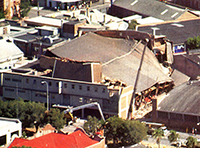News
Applying science to disaster risk reduction
Published:13 October 2016
Applying science to disaster risk reduction
Geoscience Australia is joining organisations from around the world today in recognising the International Day for Disaster Reduction.
Organised by the United Nations Office for Disaster Risk Reduction, the International Day for Disaster Reduction is held on 13 October each year and acknowledges how communities everywhere are working to reduce their exposure to natural disasters, and raise awareness of the risks they still face.
Geoscience Australia section lead Dr Martine Woolf said this year's theme 'live to tell' was an opportunity for Geoscience Australia to highlight the work it does on understanding the probability of a natural disaster, such as a damaging earthquake, occurring in Australia and its impact.
"Most people know that we monitor earthquakes, but what they might not realise is that we also do a lot research into the likelihood of a damaging earthquake. For example, the chance of an event like the August 2016 earthquake in Italy taking place in Australia and what kind of damage it would do," Dr Woolf said.
"Generally speaking, earthquakes don't kill people, buildings do. During the August earthquake in Norcia, Italy, around 300 people were killed, almost 400 were injured, and 4,500 were left homeless. Collapsing buildings were the major cause of these deaths and injuries.
"If an earthquake similar to the one in Italy occurred in populated area of Australia, we would expect widespread destruction of what is called unreinforced masonry buildings. These are generally older buildings made of materials like brick or cinderblock and have not been reinforced. The collapse of these kinds of buildings would injure and kill people, similar to what we saw in Newcastle in 1989, Christchurch in 2011, and now Norcia.
"Such extreme events like the Italy earthquake are very rare in Australia, though not impossible. Less intense events can and do occur around Australia more regularly, and have been known to cause damage and disruption."
Dr Woolf said that urban environments can be designed to help prevent injury and death during a natural disaster, such as an earthquake.
"Through our research on earthquakes, Geoscience Australia has been able to provide information and advice that has helped to improve the safety of Australian buildings," Dr Woolf said.
"Many modern buildings in Australia such as hospitals and commercials buildings, like offices and hotels, have been built with certain level of resistance to earthquakes. This is only possible if we know what kind of events they need to be resistant against."
Work undertaken by Geoscience Australia has informed Australia's building code for seismic loading in relation to residential buildings. Today's residential buildings are designed to withstand events of some severity. The level of severity a residential building has been constructed to withstand will depend on the probability of a natural disaster in the region. Where earthquakes are more likely, buildings are stronger.
Dr Woolf said that while many buildings in Australia were built before the current construction code was put in place, older structures can be retrofitted to strengthen resistance against natural disasters.
"We're currently collaborating with the University of Adelaide and the Bushfire and Natural Hazards cooperative Research Centre to examine retrofitting options for strengthening older buildings against earthquake damage."
Dr Woolf said Geoscience Australia's research into the likelihood and impacts of natural disasters aligns with the United Nations Office for Disaster Risk Reduction's Sendai Framework for Disaster Risk Reduction.
"The focus of this year's International Day for Disaster Reduction is reducing disaster mortality, one of the seven targets of the Sendai Framework," said Dr Woolf.
The Sendai Framework is a 15-year; voluntary, non-binding agreement that recognises national and state governments are primarily responsible for reducing disaster risk. The Framework also says that this responsibility should be shared with other stakeholders including local government, the private sector and the public.
Read more about this year's International Day for Disaster Reduction, including the Sendai Framework for Disaster Risk Reduction, on the United Nations Office for Disaster Risk Reduction website.
More information on natural hazards in Australia and Geoscience Australia's work on disaster risk reduction is available from the Geoscience Australia website.
Contact:
Phone:
Email:





